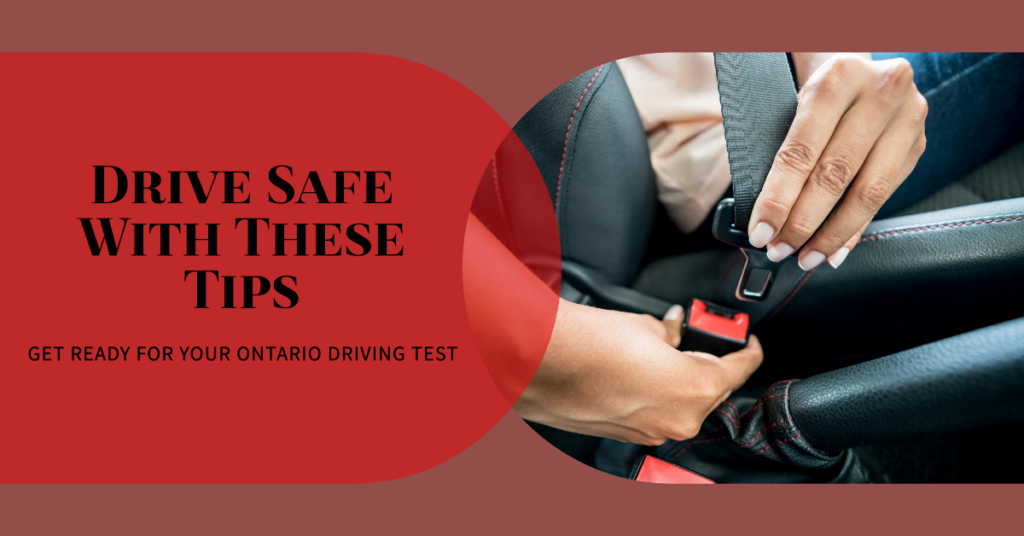A range of guidance and services has been provided in the Ontario driving study guide. The Ministry of Transportation (MTO) has introduced different measures to promote safe driving practices and maintain the safety of roads. The main goal is to improve the behaviour of everyone driving on the road. And the best option to drive safely in Ontario is by following the MTO driver’s handbook. Online version of the Ontario driving study guide is also available.
Most accidents happen when drivers aren’t paying attention to basic driving manoeuvres or because of speed. Frequently changing lanes, improper turns and running red lights can also result in collisions. Ontario driving study guide contains all the basic information a driver needs while driving. The official MTO handbook contains information regarding road rules, safe driving practices and how to get a driver’s licence for a car, van or small truck.
What Should I Know Before Start Driving?
Learning to drive is always a challenge, you need a lot of practice and also have to consider some points when you start driving. Before you start driving, consider the following:
- Get familiar with your car and understand the major functions of driving properly.
- Make the necessary adjustments before you start driving. Adjust the mirror, seats and the steering wheel as required.
- Learn about the basic dashboard controls and symbols. These buttons give access to several features, so it’s necessary to understand them.
- Always remember to wear seat belts to avoid severe injuries in case of an accident.
- Along with this, you need to carry essential documents in case a traffic police officer asks for them.
- Drinking and driving is the worst thing any driver can do. About 63,000 persons are injured every year because of drunk driving.
How Can I Drive Safely and Responsibly?
To drive safely and responsibly, you need to maintain focus on the road. The Ontario driving study guide will help you by providing all the basic information you need. Ignoring distractions is the key point you need to follow for driving safely. According to statistics, it has been found that about 26% of all road accidents involve the use of mobile phones. About 25% of teenagers admit they reply to texts while driving. This is one of the main reasons for accidents.
Defensive driving is another way to demonstrate safe driving skills. To simply define defensive driving is the technique used to prevent accidents while focusing on driving safely. The Ontario driving study guide also contains information regarding defensive driving techniques. Whether you are learning to drive or you are an experienced driver, you need to maintain a difference between you and the car in front of you. Also, it’s better to avoid driving when you are feeling tired.
What Can Driving Instructors Teach About Driving?
Although the Ontario driving study guide is the basic thing, you need to know when learning to drive. Along with this, learning from an experienced driver instructor can also help you improve your driving skills. For this, Gclass Drivers are the best option for you. Their experienced instructors will guide you through the whole process.
If you want to clear your G1 knowledge test and road test, then choosing Gclass Drivers is the best option. Aside from basic instructions, they will also tell you about your areas of improvement so that you can excel in the official test. The instructors will give you an overview of lessons and instructions regarding traffic rules and safety precautions. The main goal of driving instructors is to ensure that the students are skilled enough to drive safely on the road and pass the test.
How Do I Safely Handle Nighttime and Bad Weather Driving?
Aside from the Ontario driving study guide, the following are some tips that can help you handle nighttime and bad weather driving:
For Nighttime:
Driving at night is more dangerous than in sunlight. You need to be extra careful; however, the given tips will help you while driving at night:
- Always remember to clean your windshields, especially at night. Damaged windshields or headlights can cause the light to scatter and also increase the effects of glare.
- During the night, it’s important to put the defensive driving instincts on high alert. Be extra careful when driving.
- According to the NHTSA, there is a higher chance of drowsy driving crashes after 6:00 pm, so be aware during these hours.
- For nighttime glare, two-lane highways are the worst case scenario because of the coming car’s headlights. So it’s better to take a safer route at night if possible.
- High beams can be useful in the ruler or open areas but remember to dim the lights when you are within 500 feet of an oncoming vehicle.
For Bad Weather:
Facing bad weather conditions is a normal thing for any driver. By studying the Ontario driving study guide, you can learn about the basic safety precautions. The following tips can also help you during bad weather:
- During rain, it’s harder to control your car on a slick car, so maintain a distance with the following to stop easily.
- Reduce speed while driving during adverse weather conditions. Slowing down gives you more time to react during unexpected scenarios.
- Ensure all your windows and mirrors are clear of snow, ice, and condensation before you start driving.
- Using headlights can save you from accidents. Turn your headlights even during the day to increase visibility.
- Always carry an emergency kit in case there is an issue. Plan your trip ahead and prepare in advance.
Why is Maintaining a Safe Driving Distance Important?
Importance of maintaining a safe distance has also been discussed in the Ontario driving study guide. By maintaining a safe distance, you can prevent and avoid collisions with other vehicles. In this way, you ensure your safety as well as the safety of other drivers. When the distance is too close to other vehicles, this increases the likelihood of accidents. Another reason drivers must maintain a safe distance is to avoid blind spots.
For vehicles that are behind, providing a safe distance allows the car in front to see the blind spot areas better. According to the Ministry Of Transportation (MTO), for a Speed of 100 km/hr, the minimum distance should be 80 metres. It’s important to pay attention to the safety of other drivers and yours. And maintaining a safe distance is one of the key features that you need to follow. The Ontario Driving Study Guide has also put its emphasis on this matter.
What Vehicle Maintenance Steps Should I Take?
Following are some of the vehicle maintenance steps you should follow to ensure smooth working of your vehicle:
- Regularly checking tire pressure and rotating the tires
- Check the motor oil
- Whether the headlights and taillights are working properly or not
- Windshield wipers are in good condition
- Engine air filter is working properly
- Check the cabin air filter
- Battery is in good condition
- Inspect the brakes
- All the seat belts and hoses are in working condition
- Wash your car from time to time
How Can I Test My Driving Knowledge?
There are several ways to test your driving knowledge. Different online quizzes are present that you can take to check your knowledge test skills. The Ontario Driving Study Guide contains the information that is necessary for passing the official test. Make sure that you know all about it. For practical driving skills assessment, drive with an experienced instructor. He will guide you and will also tell you your improvement areas. Also, regularly review traffic laws and regulations to remain updated on any changes.
Conclusion
In conclusion, the Ontario Driving Study Guide, provided by the Ministry of Transportation (MTO), serves as an invaluable resource which promotes road safety. The guide covers essential topics, including road rules and regulations, defensive driving, licence information and safe driving practices. Before hitting the road, it’s crucial to know a vehicle’s functions, adjust mirrors and seats, and understand dashboard controls. Always wear your seatbelt, carry the necessary documents, and never drink and drive.
Distractions, particularly mobile phone usage, contribute significantly to accidents, emphasising the need for undivided attention while driving. Nighttime and bad weather conditions present their own challenges. Proper windshield maintenance and staying alert are key to nighttime driving while reducing speed and maintaining visibility are essential in adverse weather. Lastly, maintaining a safe following distance is emphasised, both to prevent accidents and to avoid blind spots. Gclass Drivers can help you with all this, so join us today.





